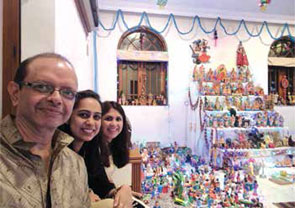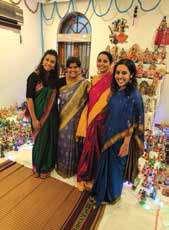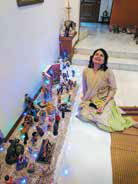In these days of incessant social media and more time spent on devices rather than conversations, here is a change to celebrate positives together, get together with friends and family and reinitiate the process of human contact

India is a land of multiple festivals, cultures and traditions and there is none so traditional as the celebrations across the country during the Navratri and Dussehra season. In the North, Dussehra marks the victory and vanquishing of Ravana by God Rama, in East the celebrations are centred around the Goddess Kali coming home to set off a period of celebration and puja and in West, it’s the Garba and its modernised celebration of Dandia that sets many feet dancing to the beat of Falguni Pathak and her ilk-whatever be the form, its all a celebration of tradition.
And there is no place where traditions are as valued and celebrated as South India, where Navaratri is seen as a time when homes in many parts of Tamil Nadu, Andhra Pradesh, Karnataka, and Kerala are agog with colours, light, music, and food. The celebration of Golu (called Bomma Golu in Andhra) is a colourful exhibition of dolls in celebration of Devi-the Goddess and a time for rejoicing, eating and bonhomie with friends and family. The floor of the home is decorated with Rangoli (Kolam in Tamil). Women in their best Kanjeevaram silks and children in colourful “pavadais” host others at home and greet them with the Golu array of dolls, mainly wooden set in stories from the Ramayan and Mahabharat and other folk lore, chanting slokas and singing traditional songs. Traditionally, the dolls display is regarded as the Goddess Parvati and consist of a multitude of idols of gods, goddesses, men, animals, and businessmen going about their work and also celebrating the festival with the occupants of homes and their visitors.

The artistic display of dolls on numbered tiers or steps, usually made of wood are traditionally on nine steps representing the nine days of Navaratri. Traditionally, a few top steps include idols of gods and a ceremonial jar with fresh water, covered with a coconut and mango leaves. The next few steps have idols of saints and heroes of the country. Another step represents human activities, depicting functions such as marriage, temples, and an orchestra or music band. Business is usually represented by the Chettiar set of dolls, with shop items and wooden “Marapachi” dolls dressed in colorful clothes adding variety to the assembly. At our home in Pune, my wife Uma’s collection of over eight hundred dolls have been assimilated over a twenty-five year period from every state in the country and over a dozen countries all over the world. A few dolls get retired and many new ones added every year.

The families eat special dishes offered to the gods, especially the protein-rich legume dish called Sundal with an ever-flowing supply of sweets and fruits. Women folk exchange betel leaves, betel nuts, coconuts, fruits, flowers, bangles, turmeric, and kumkum. The Navaratri preparations start on the new moon day by setting up the steps, decorating the homes and temples, and lighting the streets of the city in towns and villages in Tamil Nadu. The nine days of Navaratri start the next day and end on the tenth, which is called Vijayadasami (day of victory). The ninth day is celebrated with Saraswathi Pooja to worship the Goddess of learning books and musical instruments are offered along with the Golu. The tenth day is the day of victory—an auspicious day to start new ventures and journeys, and a day to start learning new skills. Possibly a good day this year for India to launch a new focus on livelihood creation and skills for three hundred million of our countrymen. On the last day, the Golu dolls are symbolically put to sleep and packed away to hibernate till Golu rolls around again next year.
I believe that traditions need to be preserved as a way to continue the process of humans bonding and working for the common good of humanity
Why are traditions like Golu so important? In these days of incessant social media and more time spent on devices rather than conversations, here is a change to celebrate positives together, get together with friends and family and reinitiate the process of human contact. A number of people today scoff at tradition and culture but while I am in the faction that deplores excessive display of religion or rituals, I believe that traditions need to be preserved as a way to continue the process of humans bonding and working for the common good of humanity. At the end of one more Golu where the 800 dolls at home entertained over three hundred guests and hopefully enthralled many first timers to this colourful tradition, here is wishing everybody the very best for the many festivals that we will be celebrating in the next few months.
Ganesh Natarajan